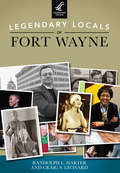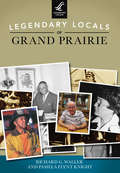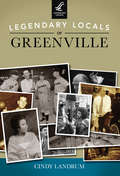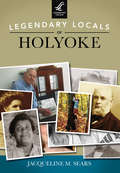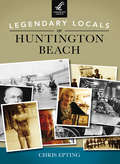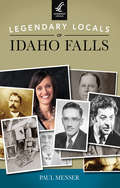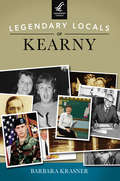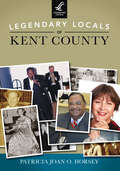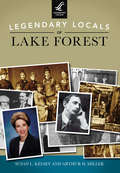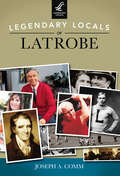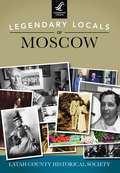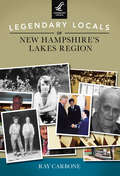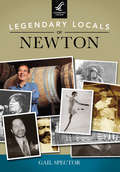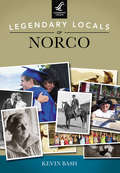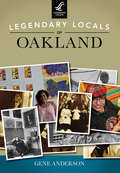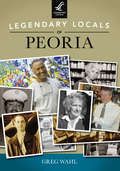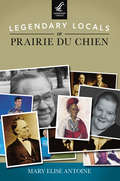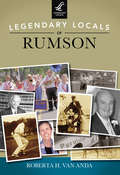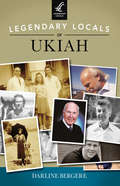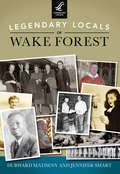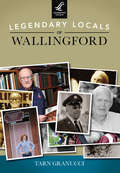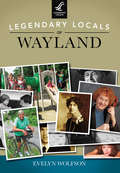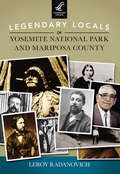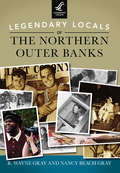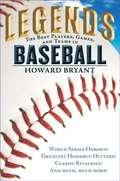- Table View
- List View
Legendary Locals of Fort Wayne
by Randolph L. Harter Craig S. LeonardFort Wayne sits astride the confluence where the St. Joseph and St. Mary's Rivers form the Maumee River. Though occupied for over 10,000 years, its modern history begins just over 200 years ago with Gen. Anthony Wayne and his Miami nemesis, Chief Little Turtle. The pageant of Fort Wayne's history includes traders, industrialists, politicians, athletes, and movie stars. Included here are such notables as Hollywood's Carole Lombard and Shelley Long, Ian Rolland of Lincoln Life, Big Boy's Alex Azar, gangster Homer Van Meter, football's Rod Woodson, inventor Philo Farnsworth, and over 150 more.
Legendary Locals of Grand Prairie
by Pamela Flynt Knight Richard G. WallerGrand Prairie is a city on the edge. Citizens have been innovators with a love for family and community. Alexander Dechmann traded land to insure a railroad depot; early settlers started schools for their families; and the police department hired one of the first women. Leaders at nonprofits such as Brighter Tomorrows not only helped the local community, but also helped develop services in surrounding communities. Business owners and volunteers have strong family traditions of giving back to Grand Prairie, and civil servants have loyalties for extended years of service, such as Ruthe Jackson and her family, who provided support for both businesses and the community. From the early settlers to today's city, Grand Prairie is built upon loyalty.
Legendary Locals of Greenville
by Cindy LandrumGreenville has long been a city of visionaries. Richard Pearis settled on the banks of the Reedy River in Cherokee hunting land where few white men would venture. Max Heller, who escaped Nazi-occupied Austria as a teen, triggered the rebirth of downtown. They are some of Greenville's local legends who have seen possibilities, not limitations. They come from all walks of life. Textile leaders such as John T. Woodside, Thomas Parker, and John D. Hollingsworth transformed the city into the "Textile Capital of the World." When textiles began to fade, businessmen and leaders such as Charles Daniel, Tommy Wyche, Tom Barton, Virginia Uldrick, Dick Riley, Carl Sobocinski, and Xanthene Norris helped transform the city once again. Stories of people who have shaped Greenville with their vision, making it what it is today, fill these pages.
Legendary Locals of Holyoke
by Jacqueline M. SearsHolyoke is home to some of the most amazing and courageous individuals. In 1658, European pioneer John Riley, along with other early planters, was instrumental in establishing a community in the West Springfield area called Ireland Parish, which eventually became known as Holyoke. This tenacious man led the way for many other trailblazers, including George Ewing, who envisioned utilizing hydropower to operate factories and inspired town engineers to design one of the first planned cities in the United States. In 1898, the progressive Elizabeth Towne encouraged Holyoke residents and an international audience with her New Thought movement that advocated a healthy lifestyle. Another outstanding citizen, Timothy Alben, judiciously leads the Massachusetts State Police, while Holyoke's Henry Jennings honorably served his country in the armed forces, as a commander of the Holyoke War Memorial Building, and on the Holyoke City Council. Barbara Bernard has astutely kept residents informed about current events for the last 70 years. Legendary Locals of Holyoke chronicles the community's finest men and women who survived and prospered through harsh circumstances and against all odds.
Legendary Locals of Huntington Beach
by Chris EptingFor over 100 years, Huntington Beach, a.k.a. "Surf City, USA," has come to represent the true beach culture of Southern California. Originally called Pacific City, it was when railroad magnate Henry Huntington first ran his train line down in 1904 from Los Angeles, approximately 40 miles north, that the then-quaint beach town took on the name that made it famous around the state and around the world. In 1914, the legendary George Freeth put on a surfing exhibition the day the city's vaunted concrete pier was opened, which christened Huntington Beach as a soon-to-be surfing mecca. It became a boomtown after oil was discovered in 1920 and, several decades later, morphed once again into a cradle of aerospace engineering when companies such as Boeing arrived. Throughout its tumultuous and dramatic history, Huntington Beach has always boasted a cast of colorful and profound characters. From the first mayor, Ed Manning, to Medal of Honor-recipient Chris Carr, from the Zamboni family (who invented the ice-cleaning machine) to baseball star Jeff Kent: the list is almost endless. But it is not just professional athletes, actors, and rock stars; it is the teachers, crossing guards, merchants, and activists that give Huntington Beach its well-earned reputation as one of the most interesting and charismatic cities in the state.
Legendary Locals of Idaho Falls
by Paul MenserIn 1864, a stage line driver named Matt Taylor and two associates decided Black Rock Canyon was the place for a toll bridge to handle traffic to and from Montana. The following year, their bridge opened and a town called Eagle Rock took shape. With the coming of the railroad, trains brought everyone from saloon keeper Dick Chamberlain to temperance crusader Rebecca Mitchell. To project a more genteel air, Eagle Rock became Idaho Falls in 1891. Joseph Clark, the first mayor, and newspaper publisher William Wheeler were just two of the people who helped pave the streets and turn on the lights. After assiduous wooing by boosters such as Bill Holden, D.V. Groberg, and E.F. McDermott, the Atomic Energy Commission in 1949 chose Idaho Falls for the headquarters of its National Reactor Testing Station. Today, Idaho Falls is a vital trading and service center with two hospitals, a professional baseball team, symphony orchestra, and world-class museum. It is also the hometown of some remarkable people who have gone out in the world to make names for themselves.
Legendary Locals of Kearny
by Barbara KrasnerHeroes lead, inspire, and perform memorable acts that shape the lives of others. In the pages of this book, readers will learn the stories behind Kearny's heroes--the people whose contributions made Kearny into the thriving, diverse community it is today. Ed Karolasz gave his life for his country during the war in Iraq. Councilman Norman Doyle helped a young girl get the medical attention she needed. College student Gabriela Salvador restores historic costumes for the town museum. Real estate developers Louis Lindblom and Edward Strong built the town's financial institutions and the Arlington section. Educators Peg Bixler and Barbara Toczko devoted themselves to their students. From the town known as Soccertown, USA, came John Harkes, Tony Meola, and Tab Ramos, who played on the United States team in the FIFA World Cup. But there was also Louis Eilshemius, the somewhat mad and reclusive artist, and Albert Gonzalez, a government informant and computer criminal. This "City of Opportunity" has produced more than its share of personalities that have created admirable and notorious international, national, and local legends.
Legendary Locals of Kent County
by Patricia Joan HorseyKent County, located on the Eastern Shore of the Chesapeake Bay, is noted for its farms, outdoor recreation, architecture, and its people. Legendary Locals of Kent County recognizes only a handful of the many Kent County people who deserve to be noted. Included are Tony Award-winning Mark Bramble, who is a director, author, and producer; controversial and colorful Evelyn Harris, also known as the "Barter Lady," who gained fame during the Depression when she proposed a system of swapping to overcome the shortage of money; elected official, school principal, minister, and artist Clarence Hawkins; Sheriff Bartus O. Vickers, who earned the respect of prisoners, lawyers, other law enforcement officers, and citizens; game warden Bozy Robinson, friend of both the hunter and the hunted; and writer Gilbert Byron, who detailed life on the Chesapeake Bay throughout the 20th century.
Legendary Locals of Lake Forest (Legendary Locals)
by Arthur H. Miller Susan L. KelseySince the 1850s, Lake Forest, located 30 miles north of Chicago on Lake Michigan, has been a distinctive suburb. It has been a retreat from the diseases, public accessibility, rougher elements, soot, stockyard smells, and general density of bustling city life. For at least five generations, it has been the retreat for Chicago's leading New England-descended families, such as the Farwells, Swifts, and Armours. And for over 150 years, Lake Forest has been the home for a community of educators, merchants, artisans, designers, and a wide variety of estate specialists, the latter from pre-Civil War escaped slaves and Scots and Irish immigrants to today's notable garden and interior artists. Legendary Locals of Lake Forest draws on rare archival images from local and Chicago public and private sources.
Legendary Locals of Latrobe
by Joseph A. CommLocated at the base of the rolling hills of the Laurel Highlands, Latrobe is best known as the birthplace of children's television pioneer Fred Rogers and golf legend Arnold Palmer. It is the home of Rolling Rock Beer, Pittsburgh Steelers training camp, and St. Vincent College. Latrobe has also been recognized for many famous firsts, like the first banana split, first all-professional football team, first Benedictine monastery in the United States, first nonstop airmail pickup, and first female nuclear scientist at Westinghouse Electric Company. It is a community of individuals who collectively exemplify the strong, hardworking culture of Western Pennsylvania--people like Oliver Barnes, a railroad engineer and Latrobe's founder; Philip Mowry McKenna, innovator in the machining of steel and father of "Kennametal" tools; Joseph E. Greubel, who transformed his family's ice cream-centered dairy stores into the thriving Valley Dairy Restaurants; Dr. Sara Carr McComb, a "legendary" librarian; and Robert Mendler, a Holocaust survivor who spent his life educating young people to respect one other. Legendary Locals of Latrobe celebrates these and nearly 200 other noteworthy figures and groups who have shaped and continue to shape the community.
Legendary Locals of Moscow
by Latah County Historical SocietyThe rich and fertile land upon which Moscow sits has sustained a vibrant community of hard working thinkers, creators, and activists for more than 125 years. Just as the area's first inhabitants returned to camas fields in Paradise Valley year after year, pioneers settled in "Hog Heaven" because they found ready access to life's necessities. Businessmen like Nathaniel Williamson and Frank David tied their fortunes to the local farming economy to the same degree as seed pioneer Willis Crites or sustainability advocate Mary Jane Butters. While the bounty that surrounds Moscow feeds its growth, the town's cultural lifeblood is pumped by the University of Idaho. The university has provided Moscow with inventors such as Malcolm Renfrew, talented athletes like Olympian Dan O'Brien, and colorful characters, perhaps best embodied by Dean of Women Permeal French. The picturesque hills of the Palouse roll through the history of this unique town, rooting tomorrow's leaders in the work of yesterday's groundbreakers.
Legendary Locals of New Hampshire's Lakes Region (Legendary Locals)
by Ray CarboneThere are few places in America that have such a rich variety of landscape and scenery as the Lakes Region of New Hampshire: from the summer calm of Squam Lake to the robust white winter mountaintops of the Gunstock Mountain Resort. So it is no surprise that the people who call it home reflect the same wide palette of humankind--from the pre-Revolutionary War surveyors who first marked their initials on a rock at Weirs Beach to Bob Lawton, the current owner of the world's largest arcade; from one of George Washington's inner circle to Ernest Thompson, the award-winning author of On Golden Pond. The Lakes Region draws them--or grows them--all, because it has it all.
Legendary Locals of Newton
by Gail SpectorNewton has more than enough legendary locals to fill volumes of books. Endless are the stories about men, women, and young people who dedicated, or still dedicate, countless hours of their lives in order to make Newton and the world a better place. Newton has been a launching ground for award-winning authors, Nobel Prize winners, Olympic medalists, and Hollywood stars. Some of Boston's best athletes have chosen to make "the Garden City" their home. In the pages of this book, readers will learn about Newton's first mayor, James Hyde, who never lost an election in more than 50 times on the ballot; Rev. Edmond Kelley, the first pastor at Myrtle Baptist Church and a former slave; Leonard Zakim, regional director of the Anti-Defamation League who dedicated his life to fighting prejudice and civil rights violations; Louise Bruyn, who walked from Newton to Washington, DC, to protest the Vietnam War; Shirley Lewis, known as the "regal queen of the blues"; and Ted Williams, regarded as baseball's greatest hitter, who lived in Newton Upper Falls.
Legendary Locals of Norco (Legendary Locals)
by Kevin BashFrom its beginning as a poultry powerhouse to World War II Navy town and to Horse Town USA, Norco has been known over time as a community of go-getters and dreamers with unparalleled volunteerism, stubbornly protecting a rural way of life. Founder Rex Clark wished for families to be self-sustaining with what they could grow and raise on their property; wounded Marine Johnny Winterholler, against incredible odds, led the way for other disabled veterans as the star of the famed wheelchair basketball team the Rolling Devils; and Tamara Ivie fulfilled her impossible dream to play professional baseball. And regular folks, known once as "Acres of Neighbors," stepped up to create a city of "elbow room," stopping cold, big-money developers wishing to cut the community into small lots. Today, Norco is an equestrian paradise with trails on most streets and plentiful open space. For decades, this small community has produced activists, ballplayers, college presidents, physicians, actors, cowboys, and lots of Norconians who give back to the community that raised them.
Legendary Locals of Oakland
by Gene AndersonOakland has been shaped by the transcontinental railroad, freeways, earthquakes, and its location on the shores of San Francisco Bay. But what makes Oakland such an amazing city are the people who have called Oakland home over the years, like Mayor Samuel Merritt, who helped make Oakland the terminus of the transcontinental railroad; Elizabeth Flood, who worked to desegregate Oakland schools in the 1870s; and F.M. "Borax" Smith, who created the Key System. Oakland has been home to game-changing athletes like "father of modern tennis" Don Budge and Curt Flood, who helped bring free agency to sports; artists like writer Jack London, dancer Isadora Duncan, poet Joaquin Miller, and cartoonist Morrie Turner; and culture-shaping movements like the Black Panther Party. However, the impact of Oaklanders is not just historical. From Oscar Grant to Favianna Rodriguez to Marshawn Lynch to Jerry Brown, people in Oakland continue to shape not just "the Town," but the entire country.
Legendary Locals of Peoria
by Greg WahlPeoria harkens back to the 1670s glory days of the French voyageurs and became the now-familiar face of Americana--its townsfolk have touched every aspect of national and international life, often significantly. In comedy, Fibber McGee and Molly, Charles Correll, Richard Pryor, Sam Kinison, and even Bishop Sheen with his witty homilies have made Peoria the "Habitat of Humor." Betty Friedan's The Feminine Mystique jump-started the 1960s feminist movement, while Philip José Farmer's The Lovers rocked the 1950s sci-fi universe. Dr. C.T. Vivian, Dr. Romeo Garrett, and John Gwynn Jr. held the frontline against racism. Representing the best of society's core values, Barb and Dick Hammond founded Friends of the Children of Haiti, a medical organization tending to the year-round needs of the earth's poorest. And unheralded Bill Noel has shouldered the sorrows and burdens of others who have leaned on him for decades. When it comes to all the legendary locals, they play in Peoria . . . and the world.
Legendary Locals of Prairie du Chien
by Mary Elise AntoineFrom the day Jacques Marquette and Louis Joliet entered the Mississippi River in 1673, fur traders, and then settlers, were drawn to Prairie du Chien. Red Bird and Black Hawk opposed American expansionism, while Zachary Taylor enforced the change. John Muir admired the majesty of the Mississippi River, and John Lawler accepted the challenge to bridge the waters. As people came to Prairie du Chien, generations worked to form a small, cohesive community. Some, like George and Dorothy Jeffers, Ralph and Albina Kozelka, Henry Howe, and Frank Stark, began businesses that descendants continue to operate. John Peacock and Mike Valley found a livelihood from the river. Art Frydenlund, Jim Bittner, and Fred LaPointe promoted and encouraged all to come. B.A. Kennedy and Jack Mulrooney created an outstanding educational and sports program. Peter Scanlan and Cal Peters recorded the rich history. Roy and Geraldine George established the George Family Foundation, and Morris MacFarlane led a movement to create scholarships. Lori Knapp helped disabled people without realizing her impact. Politician Patrick Lucey and cowgirl Elaine Kramer gained national recognition. All these people and others, like Dr. T.F. Farrell and Robert Garrity, were neighbors. Their stories fill these pages.
Legendary Locals of Rumson
by Roberta H. Van AndaIn Rumson's formative years, people journeyed to the Jersey Shore to escape the heat and pestilence in the cities. In what is now Rumson, river-to-river land parcels were developed into farms and country estates for the elite of New York City. Along with "the Baking Powder King" and "the Calico King," another of Rumson's notable residents was a US Secretary of the Interior who was asked to run for vice president, refused the honor, and left the position open for the second choice, Teddy Roosevelt. Today, one of the world's most famous and enduring singing stars and one of America's most famous chefs have ties to the town. Rumson has been the home of entertainers, sports stars, financiers, entrepreneurs, scientists, brewers, legislators, philanthropists, and jurists. It is a community that brings together people of varied interests, ages, and walks of life yet still remains a warm and comfortable small town.
Legendary Locals of Ukiah (Legendary Locals)
by Darline BergereMountains. Trees. A lake. What makes a city, town, or village come to life are the people--those who have gone before and those who are there today. They are what shape and build the community of Ukiah. With their personalities, foibles, compassion, and humor, some of these influential men and women stand out by design and some quietly exist on the sidelines. Utah Haley, a disabled veteran, drives other veterans to doctors' appointments. Rick Paige is always the first on-scene to help in a disaster. Spencer Brewer started the "Sundays in the Park" free concerts more than two decades ago. Ukiah is a town that supports its businesses, and those same local businesses give back to the community in many ways. Shannon Riley of Shoefly and Sox holds an annual shoe drive. Jan Hoyman and Doug Browe of Hoyman Browe Studios donate countless pieces of their work to charitable auctions. Ann Kilkenny of Mendocino Book Company gives time and assistance to local organizations. Marty Lombardi, who spent 40 years with Savings Bank of Mendocino, was always lending a helping hand to local nonprofits.
Legendary Locals of Wake Forest
by Jennifer Smart Durward MathenyFor much of its history, Wake Forest was an idyllic college town. Trains chugged past White Street, the depot hummed with activity, and citizens could shop for groceries, see a movie, and cheer the Demon Deacons without ever getting behind the wheel of a car. It was a town of visionaries. Samuel Wait, William Louis Poteat, Sophie Stephens Lanneau, and Peahead Walker made history in the fields of academics, religion, and athletics; when famous 20th-century writer and satirist H.L. Mencken reportedly called North Carolina "the most intelligent" of all Southern states, he was referring to Wake Forest. That tradition continues today. The Allen family publishes one of the region's most honored weekly newspapers; Andy Ammons recreated small-town magic in the community known as Heritage Wake Forest; and Steve Tarangelo followed his dream to prove that "food is love."
Legendary Locals of Wallingford
by Tarn T. GranucciLegendary Locals of Wallingford is about fabric--the fabric of community that is made up of an amazing variety of threads, yarns, and whole panels of every color, design, and origin. These represent the people of the community. Wallingford's story goes back over 350 years and encompasses an enormous range of people with every kind of motivation for being part of this town. The people of this community love where they live and give back to the townspeople who have supported their businesses, educated their children, and protected them in so many ways. Wallingford has produced a number of people of celebrity, including Morton Downey, the famous singer and songwriter of the 1920s and 1930s, and also his son Morton Downey Jr., who earned a name for himself in the TV talk show world; Beverly Donofrio authored Riding in Cars With Boys; Maureen Moore acts on Broadway; sculptor Robert Gober recently completed a major show at MOMA in New York; and Maj. Raoul Lufbery was a renowned World War I Flying Ace. These and more are celebrated here.
Legendary Locals of Wayland
by Evelyn WolfsonWayland's historic district is dominated by the 1815 First Parish Church, designed and built by Andrews Palmer of Newburyport, who adapted an Asher Benjamin design. The Rev. Edmund Sears served as minister for 17 years and wrote "It Came Upon the Midnight Clear" for a First Parish Sunday school celebration in 1849. Wealthy Bostonians soon established summer homes in town. Willard Austin Bullard purchased the residence beside the church and christened it Kirkside, and William Power Perkins purchased Mainstone Farm and established the first Guernsey cow farm in the state. By the mid- to late 1800s, Cochituate Village was dominated by a well-established shoe industry and stately Victorian homes lined the streets. A little more than a century later, the town was preparing for an influx of folks from the city. Howard Russell and Allen Benjamin created an official town map, designating streets, and delineating the established uses for the town's 15.2 square miles. Thanks to the vision and hard work of these men and others like them, the town still retains a semblance of its rural atmosphere with almost 3,000 acres of permanently protected open space.
Legendary Locals of Yosemite National Park and Mariposa County (Legendary Locals)
by Leroy RadanovichIn 1846, Thomas Larkin, American council general to the Mexican government in California, purchased a Mexican land grant, Las Mariposas, for Col. John C. Fremont. The grant consisted of 10 square leagues of grazing land located near the Merced River and west of the Sierra. In 1848, when California became the possession of the United States, the treaty called for the recognition of preexisting grants. Gold was discovered in the foothills of the Sierra that same year. Fremont floated his questionable Mexican grant into the gold discovery region. With the formation of the State of California in 1850, one of the original counties was named Mariposa, Spanish for "butterflies." Located within the county was the Fremont grant and much of the yet undiscovered Yosemite region of the Sierra. Encounters with Native Americans near the mining camps lead to the formation of the Mariposa Battalion, and a search for the natives led to the American discovery of Yosemite Valley. Thus, it was custodians and photographers such as Charles Leander Weed, Carlton E Watkins, J.J. Riley, George Fiske, Ansel Adams, and many others that interpreted and introduced Yosemite to the world.
Legendary Locals of the Northern Outer Banks
by R. Wayne Gray Nancy Beach GrayThe remoteness and isolation of North Carolina's northern Outer Banks has shaped both early settlers and relative newcomers into tough and independent souls. Sir Walter Raleigh's colonists may have mysteriously disappeared from Roanoke Island, but the enterprising homesteaders who followed managed to eke out a living on the windswept and battered banks. Entrepreneur E.R. Daniels ran a line of mail and freight boats that helped connect the Outer Banks to the outside world. Former slave and Civil War hero Richard Etheridge did not shirk from an opportunity to become the first black keeper of a lifesaving station. In the mid-20th century, leaders like Bradford Fearing saw the importance of developing tourism, so that people would come see Paul Green's new outdoor drama, The Lost Colony. Outer Bankers have warmly welcomed visitors, from the time the Wright brothers arrived to today's modern tourists. The challenge now is to balance commercial growth with environmental sensibility so that oystermen, like Georgie Daniels, and fishermen, like Dewey Hemilwright, can continue to ply the waters.
Legends: The Best Players, Games, and Teams in Baseball
by Howard BryantExperience baseball's most exciting moments, World Series heroics, greatest players, and more! Baseball, America's pastime, is a sport of moments that stand the test of time. It is equally a sport of a new generation of heroes, whose exploits inspire today's young fans. This combination makes for a winning debut in Legends: The Best Players, Games, and Teams in Baseball. This is no traditional almanac of mundane statistics, but rather a storyteller's journey through baseball's storied game. Told in fun, accessible chapters and accompanied by iconic photos, a slew of Top Ten lists for kids to chew on and debate, and a Timeline of the 40 Most Important Moments in Baseball History, this collection covers some of the greatest players from Babe Ruth to Hank Aaron; the greatest teams to take the field and swing the bats; the greatest social triggers, such as Jackie Robinson's breaking of the color barrier; the greatest playoff rivalries, including the 2004 showdown between the Red Sox and Yankees that turned into an instant classic; and, of course, the edge-of-your-seat World Series moments that left some cheering while others wept. This is the perfect book for young fans eager to learn more about the sport that will stay with them for a lifetime.
